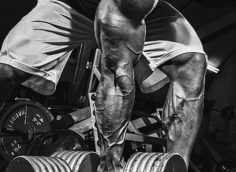A Better Back Workout
The upper back deserves more attention. Sure, it's important for posture and shoulder health, but it's also a sign that you know what you're doing in the gym. Try a couple of these training methods in your next back workout. You'll feel better, look better, and get stronger.
When training the upper back, many try to go as heavy as possible, which means they sacrifice form for plates. Instead, focus on intention throughout the entire range of motion, maintain that intensity, and own the exercise.
When average lifters go lighter, they'll tell you it's too easy, or they don't feel anything. But, in reality, they're going through the motions with no purpose. They don't know how to make light weight feel heavy, which is a skill most jacked people have mastered. Keep this in mind when testing out these five methods below.
You can do countless band exercises for the upper back, but the "band tear" or pull-apart should be a staple.
Keep your arms relatively locked out so the emphasis stays on the upper back throughout the movement. Maintain speed and tension throughout.
You can do these with different joint-specific angles and positions to vary the stimulus. There are hundreds of different ways to do it. Some examples:
- Grip: Overhand or underhand
- Angle of the Tear: Diagonal tears or elbows in
- Band Position: Anchor it at different heights
Perform these with higher rep ranges – 15 to 25 or more. Or you could do them for total-rep sets: try completing 100 reps with perfect form using as little rest as possible.
Few people use the sled to train the upper back. Too bad. Movements like face-pulls and high pulls are a great way to target the upper back for new growth.
If you haven't had formal training with the O-lift variations, using a sled for the high-pull is a safer alternative, especially since this version has no eccentric portion.
If this is your first time doing the high-pull, it involves a little leg drive, but you complete it by pulling the handles high towards the face. You can do these movements for a specific number of reps, but going for total distance or time also works.
Exercises such as the prone YTW, the scarecrow, or any isometric hold can be extremely humbling to even the strongest lifter.
The upper back and shoulders aren't designed to be trained with a lot of weight, not only from a structural standpoint but also from a mechanical perspective. When loading these, keep that in mind and use the less-is-more approach with plates or dumbbells ranging from 2.5 to 15 pounds. Depending on the exercise, that may be all that's required.
Now do the YTW using your own body weight. Suspension straps will give you a pretty significant training stimulus compared to a resistance band or light pair of dumbbells.
Keep a neutral body position and progress the exercise by walking in closer towards the anchor position. The more upright you're standing, the easier it'll be. These are tougher than they look, so start with a simple loading scheme: 3 sets of 8-12 reps. Gradually progress by changing the body position.
Lowering dumbbells slowly or holding a long isometric squeeze can quickly turn an easy task into a tough set. Doing either of these also helps create more tension and intent throughout the exercise.
For the first method, focus on holding one side while performing the reps on the other. For the second, amp up your mind-muscle connection – and potentially fix your form – by lowering slowly and with control. Do it right and it'll make your 10-pound dumbbells feel like a hundred.





